Trivandrum Sightseeing
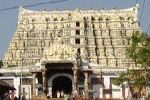
The Anantha Padmanabhaswamy temple
Located inside the East Fort of the city, The Anantha Padmanabhaswamy temple is an icon of Thiruvanathapuram. The entire city is built around this oasis of grandeur and peace. The most sacred shrine amongst the 108 Viashnavite Temples, this pantheon is believed to be from pre-Christian era. In 18th century, Maharaja Sri Anizham Tirunal Marthanda Varma, the King of Travancore renovated the temple and from that time it became associated with the rulers of that Kingdom. The Maharajas of Travancore called themselves Padmanabha daasas (The Servants of Padmanabhaswamy) and upheld the reigns in the name of Padmanabhaswamy. The royal crown of Travancore Kings is now placed in this temple.
Padmanabhaswamy means the God who has a ‘Lotus Navel’. The idol of Lord Vishnu placed in the sanctum of the temple is 18 feet long and is seated in reclined position. The deity is resting on Anantha – the celestial serpent and a lotus can be seen growing from his navel. This lotus carries Lord Brahma.
Noteworthy for its architectural marvel, this temple was nominated into the last round of the Seven Wonders of the World. The structure of this temple exhibits a fine combination of traditional Kerala style inflicted by Dravidian school of architecture with the splendid Tamil style framework. The corridor supported by 500 pillars all showcasing beautiful engravings, the enchanting musical pillars, the grand golden Mandapam, Mural Paintings and ‘Padmatheertham’, the large pond are some of the prominent architectonic features of this temple. The Gopuram of the temple offers a spectacular view of the city.
Electricity is not used inside the temple and the light is generated only from the oil lamps. An entry to the temple is open only for the Hindus and the visitors must follow the dress code, i.e. Kerala Mundu (White Dhoti). For men it is compulsory to wear only Mundu and nothing on the top. Women can either wear sari or wear Mundu over their salwars. The idea behind this is that, you cannot show your legs separately.

Padmanabhapuram Palace
Recognized by the ‘Guinness Books of World Records’ as World's largest Wooden Palace, the Padmanabhapuram Palace is situated at a village named Thuckalay, nearly 63 km from Thiruvananthapuram, at the footings of the Veli Mountain Ranges. Entirely built in teakwood and rosewood, this 16th century palace served as the headquarters of the royal family of Travancore Kingdom.
The pompous Darbar Hall built in rosewood and glass adds to the amplitude of the palace. The 600 years old spice bed, sandal pillars, the clock tower; one of the oldest cock towers in South Asia, granite dance halls, beautifully carved mahogany ceilings, mica windows, wide range of Murals, Belgian mirror, etc are some of the distinct features of the Padmanabhapuram Palace.
The flooring of the palace was built in glossy granite and some rare Ayurvedic herbs were mixed with it so as to keep the floor cool in summer and warm in winter and monsoon. Apart from this, it also contained a unique composite of egg white, lime, jaggery, burnt coconut, river sand and charcoal. This wonderful and extraordinary floor was built by Iravipillai Iravivarma Kulasekhara Perumal, the king of Travancore in 1601 AD. The chambers like Mantrasala, Natakasala, Thai Kottaram, Thekee Kottaram, etc are highlights of the architectural opulence of Padmanabhapuram Palace.
Though this Palace belongs to Kanyakumari district of Tamil Nadu, the Government of Kerala is responsible for the maintenance of the palace. The royal sword of the kings of Travancore is preserved in this palace. The Padmanabhapuram Palace, a melting pot of history, architecture and heritage leaves the beholders dumbfounded with its architectural magnitude and splendid engineering ingenuity.
The palace remains closed on Mondays.
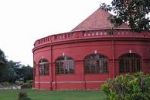
The Kanakakunnu palace
Built during the governance of King Sree Moolum Thirunal, the king of Travancore, this palace is situated just next to the Napier Museum. Set up on a small hill surrounded by meadows, the Kanakakunnu Palace was originally used as the summer retreat of the royal family. The royal guests were also entertained at this palace and royal banquets were organized here. Later, King Chithira Thirunal renovated this palace and also constructed a tennis court inside, for royal amusement.
Presently the Kanakakunnu Palace belongs to the Government of Kerala. The tourism department has converted this palace into a venue for cultural programs and tourist picnic spot. The All India Dance Festival which extends from October to March is organized here every year. Classical Dance performances like Bharatanatyam, Kathak, Mohiniyattam, Odissi, Ballet and other folk dance performances are organized at Nisagandhi, the open air theatre in this palace.
The Kanakakunnu palace also hosts the week long food festival and major hotels from entire Kerala take part in it. If you alight at Thiruvananthapuram during Onam season, you should not miss paying a visit to the Kanakakunnu palace as it is brilliantly illuminated during Onam period.
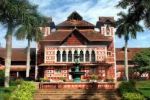
The Napier Museum
Named after General John Napier, a former Madras governor, ‘the Napier Museum’ is about 150 years old. Situated in the ‘museum compound’ adjacent to a Zoological Garden, nearly 800 meter from the Kanakakunnu palace, this museum is one of the prominent benchmarks of Thiruvananthapuram. Built by Travancore Kings in 1855, the Napier Museum displays the cultural and historical assets of Kerala. Designed by an English architect named Robert Fellows Chrisholm, this museum presents an exquisite combination of English-Saxon-Travancore architectural pattern and style.
The exhibits displayed in this museum include rare historical and archaeological artifacts like bronze idols, stone sculptures, ceramics, wood and ivory carvings, a wooden cart, Buddhist statues, Balinese shadow puppets, Kathakali models, musical instruments, temple chariots, chests, antique jewelry, old coins, Chinese items etc. The enthralling roof of the museum and the minarets give a gothic air to the entire scenario which leave the spectators wonderstruck. The museum is designed in such a way that it is gifted with a natural air-conditioning system.
This government art and craft museum is open from 10:00 am to 5:00 pm. It is closed on Mondays and till afternoon on Wednesdays. Entry fee is just 5 Rs. and photography is not allowed. There is no signboard saying Napier Museum and you will have to identify it by its black and red brick Indo-Saracenic structure.
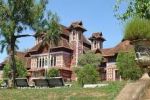
Sree Chitra Art Gallery
Located just next to the famous Napier Museum and about 2 km from the Thiruvananthapuram railway station, The Sree Chitra Art Gallery exhibits a rare collection of Indian paintings. They include some of the exceptional paintings by world renowned painters like Raja Ravi Varma, Nicholas Roerich and Svetlova. Other works from Rajput, Tanjore and Mughal schools of art, Kerala mural paintings, Tanjore miniature paintings, Japanese, Tibet, China and Bali paintings etc are showcased here. The gallery is open from 10:00 am to 4:45 pm. It is closed on Mondays and till noon on Wednesdays.
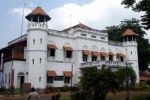
Science and Technology Museum
Situated very close to the Postmaster General's Office near the Napier Museum, The Science and Technology Museum was established by the Kerala Government in 1984. The main aim behind the establishment of this museum was to imbibe within the youngsters a craving for scientific study and new technological discoveries. The ability to think, ask questions and explore is inculcated and developed in the children here. Games and enjoyment is combined with serious studies here and instead of merely learning from books, children are provided a direct approach to things and scientific facts.
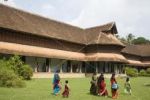
Putan Malika Palace ( Kuthira Malika Palace )
Situated on the South east of the Padmanabhaswamy Temple in Thiruvananthapuram, the ‘Putan Malika Palace’, also known as Kuthira Malika Palace was designed by the King Maharaja Swathi Thirunal Balarama Varma. This king of Travancore was very popular for his interest and genius in music and poetry. This 18th century palace is built facing the holy pond of the temple known as Padmatheertham.
The Putan Malika Palace belongs to the royal family of Travancore. Very recently they have opened up this palace for public visits so that they can easily raise the funds and manage the maintenance of the palace. This palace is famous especially for the horse shaped windows and numerous horse faces carved in the wooden framework. The palace gets its name ‘Kuthira Malika’ after this characteristic design. Kuthira means horse, and Malika or Maliga means face.
The major attractions of the palace museum that enthrall the spectators are wooden screens embedded with delicate carvings, portraits and oil paintings of royal family members, ivory throne, a solid crystal throne endowed by the Dutch from Bohemia, antiques and artifacts taking back to Maharaja Swati Thirunal's times, swords, muskets and other weapons, palanquins and 'Howdas', etc.
The Putan Malika Palace is an exquisite example of extravagant Kerela architecture. The palace is built in pure wood. Wooden ceilings embellished with minute carvings, pillars decorated with engravings, the special ventilation system that keeps the chambers cool, polished floor, wooden benches, sloping tiled roof present a meticulous paradigm of Travancore genre of architecture.
Presently the palace hosts the famous Swathi Thirunal Music Festival and many other musical concerts and Carnatic Musical festivals organized by the royal family. Apart from that, some parts of the palace are dedicated to dances, debates and meditation.
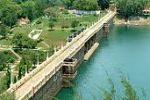
The Neyyar Wild Life Sanctuary and Dam
The Neyyar Wild Life Sanctuary and Dam are situated about 32 km from Thiruvananthapuram at the juncture of three rivers; the Neyyar, the Mullar and the Kallar. Built in 1958, this dam and wildlife sanctuary has become a favorite tourist destination today. Parked at the foothills of the Western Ghats, this picnic spot offers a very panoramic view of the surrounding hills and the dam perched in their lap.
A beautiful lake situated near the dam make a very adorable site. The jungle that encompasses the Neyyar Dam is noteworthy for its rich variety of flora and fauna. Many rare herbs very important in Ayurvedic medicine naturally grow here. The major attractions of this place include a crocodile farm, a watch tower, a lake garden, a swimming pool, a diminutive wild life sanctuary, boating facilities, mountaineering, deer park and Lion safari park.
The Neyyar Wildlife Sanctuary, spread over an area of 128sqkm shelters numerous wild animals like, elephants, deers, sambar, gaur, Nilgiri langur, jungle cat, sloth bear etc. the crocodile farm is maintained by the Wildlife department of State Government.

Aruvikkara Dam
Just 8 km from the heart of the city is located the Aruvikkara Dam. Built over the Karamana River, this dam has become a famous weekend get away from Thiruvananthapuram and a popular picnic spot. Apart from the scenic beauty of the dam, other attractions of this place that charm the tourists are; the beautiful stream and the sacred temple. The stream that flows near the dam has abundant fish of different colors, shapes and sizes. People enjoy feeding these fish. On the banks of the Karamana River is placed a temple dedicated to the Goddess Durga.
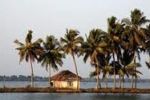
Kovalam
Your trip to Thiruvananthapuram can never be complete unless you have discovered the magical bliss and glamorous trance hidden behind the sun, sea and sand of Kovalam. A 17 km journey from the heart of the city will reach you to the world famous beaches of Kovalam. Recognized worldwide as one of the loveliest beaches on the globe, Kovalam is haunted by tourists since 1930. Kovalam means coconut. The coconut groves and palm fringed beaches of Kovalam promise ecstasy on earth. The emerald green water of the Arabian Sea ridden by the icy swirls, the miles of golden white sand and the rich coconut orchards render this beach a paradise incarnated.
Kovalam boasts of a cluster of four alluring beaches namely: Ashok Beach, Samudra Beach, Light House Beach and Eve’s Beach. All of tem are just divided by rocky projections and can be reached on foot. These beaches are extremely safe for swimming. Sun bathing and water sports attract both the local and foreign tourists. Apart from the aquatic activities, the shops that sell jewellery, handicrafts, artifacts and clothes and the delicious sea food interest the visitors a lot. Kovalam beaches are over crowded during November and December.

Lighthouse Beach
The most famous of the four beaches of Kovalam, the Light House beach is situated about 10 km from Thiruvananthapuram. The southernmost part of the Kovalam beach resort comprises the Light House Beach. On the top of a hill named Kurumkal is parked a light house called Vizhinjam Lighthouse. This beach is christened after the Vizhinjam Lighthouse as the Light House Beach. Vizhinjam Lighthouse is 35 meters in height and is elegantly painted in the attractive combination of white and red. This light house can be clearly seen from any part of the beach.
Going inside the lighthouse is not permitted but the monoliths of Ayyanappilla Asan and Ayyippilla Asan surround the lighthouse. This is a very important place to visit. The sapphire blue ocean, the shiny silver sand and swaying palms define beauty to its truest sense. Often referred to as the “Paradise of the South”, this beach offers the tourists an overdose of pleasure and relaxation. Though the beach is very safe for swimming, lifeguard equipments are made available here. The recreational area encircling the beach comprehends several cafeterias that provide very delectable and appetizing varieties of sea food. Rejuvenating Ayurvedic Massage can be enjoyed at the massage parlors. Sunbathing and water sports are additional attractions of the Lighthouse Beach.

Hawah Beach
Situated about 15 km from Thiruvananthapuram, the Hawah Beach is also known as the Eve’s Beach. Renowned for its natural pulchritude and splendid comeliness this beach stands separated from the four beaches of Kovalam by a foreland named Edakullu. It is believed that every sunset observed from this beach is distinct and bears no resemblance with the previous one. And each of them is equally beautiful in its distinguished manner. The shops that encircle the beach sell ornaments, clothes, handicrafts, shells, artifacts and many more souvenir items.
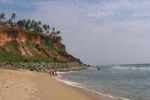
Varkala
Located approximately 50 km North West from Thiruvananthapuram, Varkala is the only place of South Kerala where cliffs are seen alongside to the Arabian Sea. Very well known as Varkala Formation, these cliffs are declared by the Geological Survey of India as an exceptional geological monument. Another famous attraction of Varkala is the Janardana Swami Temple, which is believed to be nearly 2000 years old. This is a very sacred shrine and a very important pilgrim place for Vaishnavaites.
Varkala, also known as Dakshin Kashi is also renowned for its Papanasam Beach. Devotees believe that once you bath in the holy waters of this beach, all your sins will be washed. Apart from this, the beach offers a safe swimming and water sports. Sun bathing and watching sunset are also favorite activities pursues here.
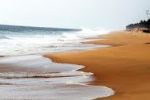
Shanghumukam Beach
Situated close to the Thiruvananthapuram airport and just 8 km from the Thiruvananthapuram main city, Shanghumukam Beach - an exotic weekend getaway is a must visit place. Sky painted in different shades of orange and red at the time of sunset look prettier and even more elegant from the Shanghumukam Beach. If you are looking for a peaceful and serene holiday in the cradle of nature, the best option you can go for is the Shanghumukam Beach. The beach is adorned with a 35 meter long mermaid statue. A fanciful restaurant built in the shape of a huge starfish attracts the visitors even more.
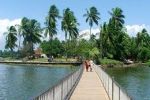
Veli Tourist Village
In the lap of the fortunate place where the two lovers – The Veli Lake and The Arabian Sea unite for eternity is situated the popular Veli Tourist Village. Merely 8 km away from the heart of the city Thiruvananthapuram, this village is specially developed for the tourism purposes. You can hire pedal boats or speed boats and explore the village. Both children and grown ups are sure to enjoy a trip to Veli Tourist Village.
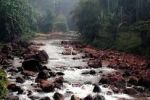
Ponmudi
Ponmudi: the famous hill resort is situated roughly 61 km from Thiruvananthapuram. A home to zigzag pathways and flourishing green ambiance, Ponmudi is parked at the altitude of 915meters above sea level. The towering hills, unknown but beautiful wild flowers, tiny rivulets, cascading springs and delicate butterflies make this place a utopia of south India. Ponmudi also houses a must visit deer park.
This hill resort is also the perfect option for the adventure seekers as it offers the best of the trekking and mountaineering opportunities. Reaching Ponmudi is not very difficult. You can rent a car or taxi from Thiruvananthapuram at very affordable rates. The way to Ponmudi from Thiruvananthapuram is extremely scenic and panoramic.
The journey to Ponmudi through this narrow, meandering and picaresque road is very pleasant and refreshing. The inherent beauty of lush green landscapes and the glittering golden valley of Ponmudi fascinate the tourists to no extent.
.


